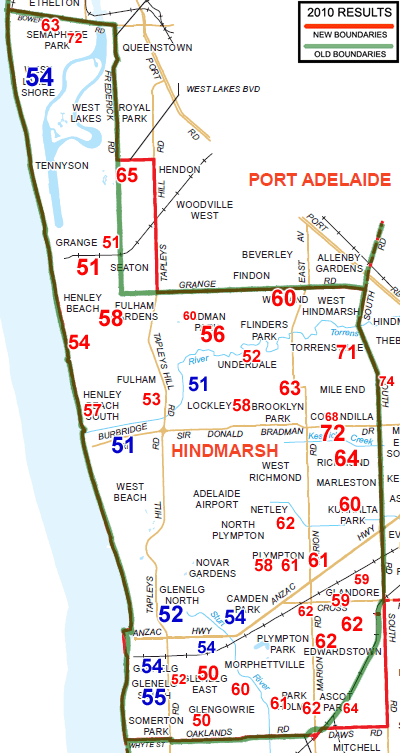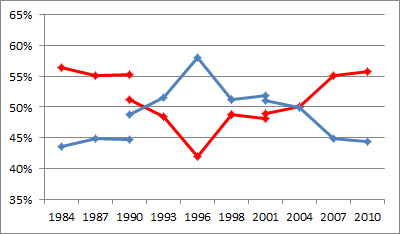UPDATE (9/7): The latest weekly Essential Research poll has the two-party vote steady at 56-44, from primary votes of 31% for Labor (down a point for the second week in a row), 49% for the Coalition (steady) and 11% for the Greens (up one). There are further questions in asylum seekers, of which the most illuminating is the findings that 60% believe the government is too soft, the carbon tax (31% say they have noticed an increase in costs, 54% say they haven’t) and the European economic crisis.
UPDATE 2: Roy Morgan has published poll results from its last two weekends of regular face-to-face surveying. This has both parties down on the previous fortnight, Labor by 3% to 29.5% and the Coalition 2.5% to 45.5%, with the Greens up 4.5% to 14.5%, their best result since February and equal best result ever. The Coalition’s two-party lead is down from 54.5-45.5 to 54-46 on previous election preferences, but up from 56.5-43.5 to 57.5-42.5 on respondent-allocated preferences.
Before we proceed, two automated polls from ReachTEL which were published earlier in the week:
• A poll of 646 voters in Dobell points to a crushing victory for the Liberals, regardless of whether Craig Thomson remains as Labor candidate (which would not appear likely, as the party is proceeding with the preselection process while Thomson’s membership is suspended). Without Thomson, the primary votes after exclusion of the undecided are Liberal 61%, Labor 30% and Greens 6%. With Thomson, the results are 64%, 21% and 13%. The former set of figures suggests a two-party split of about 64-36 and a swing against Labor of around 20%, which seems a bit much. Imre Salusinszky of The Australian reports Labor sources have “confirmed the party hoped to finalise its candidate by the end of the year, which would make it impossible for Mr Thomson to clear the legal issues surrounding him in time to resume his party membership and nominate”.
• A 1051-sample poll of state voting intention in Queensland had the primary vote at 56.5% for the LNP, 21.8% for Labor, 9.4% for the Greens and 7.4% for Katter’s Australian Party. This compares with election results of 49.6%, 26.7%, 7.5% and 11.5%.
Now then.
Created when South Australia was first divided into electorates in 1903, Hindmarsh was traditionally a safe Labor seat covering Adelaide’s working class north-western suburbs. The creation of Port Adelaide as a separate electorate in 1949 made it somewhat less secure, pushing it southwards into more conservative Henley Beach, but only in 1966 was long-term Labor member Clyde Cameron seriously threatened. The watershed moment in its progress from safe Labor to marginal came in 1993, when the abolition of Hawker drew the election further south into Liberal-voting Glenelg. It currently extends along the coast from Glenelg South north to Semaphore Park, from which it extends inland to mostly Labor-voting suburbs south of Grange Road, from Kidman Park to Torrensville south to Morphettville and Ascot Park. The redistribution to take effect at the next election has effected two minor gains, both to Labor’s slight advantage: 3300 voters at Seaton in the north from Port Adelaide, and 1500 voters at Edwardstown in the south from Boothby. Labor’s notional margin is now 6.1%, compared with 5.7% at the election.
The Liberals’ first win in the seat followed the aforementioned redistribution at the 1993 election, at which a cut in the notional margin to 1.2% coincided with the retirement of sitting Labor’s John Scott, who had been the member since 1980. The Liberal candidate was Christine Gallus, who had become the first Liberal ever to win Hawker in 1990. She duly followed by becoming the first Liberal to win Hindmarsh, defeating future state government minister John Rau with a 2.8% swing. Party hard-heads rated Gallus’s vote-pulling power very highly, and they were duly dismayed when she decided to retire at the 2004 election. The Liberals were also damaged by a redistribution that added a northern coastal spur through Grange to Labor-voting Semaphore, which cut the margin from 1.9% to 1.1%.
It was thus widely expected that the seat would fall to Labor candidate Steve Georganas, a former taxi driver backed by the “soft Left” faction in a deal that saw the Right’s Kate Ellis take Adelaide. So it proved, but Georganas was given a run for his money by Liberal candidate Simon Birmingham, who limited the swing to 1.2% and came within 108 votes of victory (and went on to become a Senator in 2007). Georganas’s margins were increased by 5.0% and 0.7% at the elections of 2007 and 2010, which represented modest growth by the standards of other South Australians, such that the margin is now substantially lower than in three seats (Makin, Kingston and Wakefield) which Labor had been unable to win in 2004. This partly represented the party’s lack of mortgage-paying areas, and their attendant electoral volatility.
Nonetheless, Mark Kenny of The Advertiser reported in May that Liberal internal polling showed Hindmarsh to be the party’s most likely gain in South Australia. Their candidate is Matthew Williams, national business development manager with law firm Piper Alderman.









Crikey is committed to hosting lively discussions. Help us keep the conversation useful, interesting and welcoming. We aim to publish comments quickly in the interest of promoting robust conversation, but we’re a small team and we deploy filters to protect against legal risk. Occasionally your comment may be held up while we review, but we’re working as fast as we can to keep the conversation rolling.
The Crikey comment section is members-only content. Please subscribe to leave a comment.
The Crikey comment section is members-only content. Please login to leave a comment.